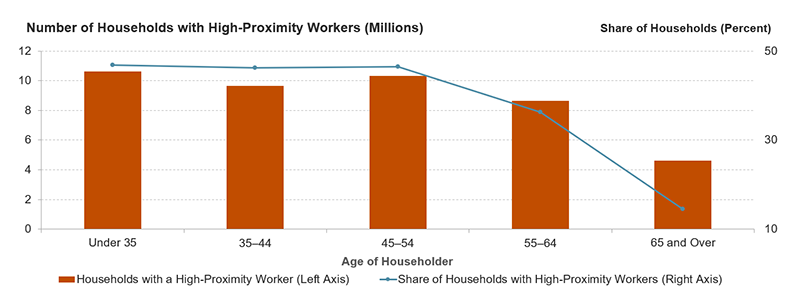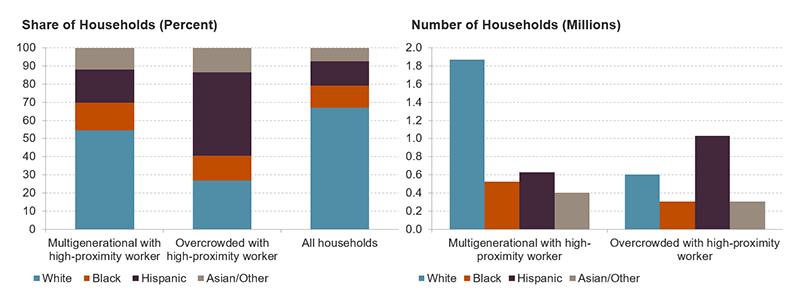High-Proximity Jobs and Household Vulnerabilities
In about a third of all households—and in at least 40 percent of black and Hispanic households—at least one person works in a job that requires them be close to other people, which could increase their risk of catching COVID-19. These include about 5.4 million households that are especially vulnerable because they are multigenerational with older adults and/or are living in overcrowded conditions.
Why might overcrowded or multigenerational households be associated with greater vulnerability to the spread of COVID-19? Overcrowded households have more than one person per room. If a household member is exposed to COVID-19, there is typically not sufficient space in the home to properly self-isolate. Older adults are also more susceptible to the virus. In multigenerational households, there are often complex care arrangements between older adults, their children, and sometimes their grandchildren. In multigenerational households with a high-contact worker, it could also be difficult to maintain this care without exposing older adults to the virus.
High-contact jobs and household vulnerabilities are especially important to consider as more people return to work and as people continue to work in places where the virus hasn’t been fully contained. To estimate how many households might be in this position, I used the physical proximity index from the US Department of Labor to identify high-contact jobs. An index score of at least 75 indicates that the job requires workers to be within an arms-length of others – including waitresses, taxi drivers, post office clerks, and personal care aides – and almost universally cannot be performed remotely. I mapped the physical proximity index onto American Community Survey Standard Occupational Classification (SOC) codes to identify households with at least one high-proximity worker and then explored the characteristics of potentially vulnerable households.
In over a third of all households (43.9 million), at least one person works in a job that requires close contact. A greater share of households of color rely on high-contact jobs, including 40 percent of black households and 45 percent of Hispanic households, as compared to just 34 percent of white households. Younger households, including 46 percent of those with prime working-age householders under 55, are also more likely to have at least one earner in a high-proximity job (Figure 1). The share drops to just 36 percent for those with householders aged 55–64. The racial and age disparity also means that homeowners with a mortgage and renters are more likely to work in high-contact jobs than homeowners who own their homes free and clear.
Figure 1: Younger Households Are More Likely to Have at Least One High-Proximity Worker
Notes: High-proximity jobs have a physical proximity index score of at least 75.
Source: JCHS tabulations of US Census Bureau, 2018 American Community Survey 1-year estimates and US Department of Labor, Physical Proximity Index.
While households headed by an older adult are less likely to have people working in high-contact jobs, there are still many multigenerational and households with older adults that rely on these jobs for income. In total, 6.6 million households with high-contact workers have an older adult (aged 65 and over) present, including 1.0 million in which the older adult is over age 80. Many of these households consist only of older adults, but just over half (3.4 million) are multigenerational families in which the older adult lives with an adult child and/or a grandchild.
Multigenerational households with high-proximity workers are disproportionately headed by a person of color (Figure 2). For example, 15 percent of these households are black (compared to 12 percent of all households). Similarly, 18 percent are Hispanic (compared to 13 percent of all households) and 12 percent are Asian or another non-white race/ethnicity (compared to 7 percent). Multigenerational households are also more likely to live in overcrowded conditions with the triple vulnerability of having a high-contact worker, an older adult who may have care needs or provide care, and a lack of space for self-isolation. More than three-quarters of the 275,00 very vulnerable households in this position are headed by a person of color.
Figure 2: Households with High-Proximity Workers Are Disproportionately Headed by a Person of Color
Notes: Multigenerational households have at least one person age 65 or over and live with a child or grandchild. Overcrowded households have more than one person per room. High-proximity jobs have a physical proximity index score of at least 75. Multigenerational and overcrowded household categories are not mutually exclusive. White, black and Asian/other householders are non-Hispanic. Hispanic householders may be of any race.
Source: JCHS tabulations of US Census Bureau, 2018 American Community Survey 1-year estimates and US Department of Labor, Physical Proximity Index.
Out of all overcrowded households, just over half (2.2 million) have at least one worker in a high-proximity job. In part due to the overlap with multigenerational households, an astounding 46 percent of overcrowded households with a high-proximity worker are headed by a Hispanic person. Additionally, nearly two-thirds of overcrowded, high-contact households are renters, as compared to an overall rentership rate of just 36 percent.
In total, 5.4 million households with high-contact workers have either multigenerational families and/or overcrowded conditions that would make them particularly vulnerable as people go back or continue to work. (This total, of course, does not include additional households in which an immune-compromised person lives, which are difficult to identify but would also have vulnerabilities.) Foregoing a paycheck to prevent contact is not an option for many of these households. And given that households with high-proximity workers are more likely to be headed by a person of color, vulnerabilities in household composition and living conditions may also deepen racial disparities in the spread of the virus.
Solutions are not simple, especially for multigenerational households that can have complex care arrangements within families. Extending unemployment insurance to high-proximity workers in these vulnerable households could help. Typically, eligibility for unemployment only comes with a furlough or layoff. But high-proximity workers with overcrowded or multigenerational household compositions may need to stay home to ensure that the virus is not spread through their households. Providing temporary income support, either through unemployment and/or paid sick leave, could give these workers the flexibility to remain home. Finally, housing assistance, both in response to the pandemic and after, would help doubled-up households in overcrowded situations afford separate accommodations.



